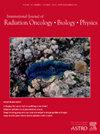Radiation Therapy for Pleuropulmonary Blastoma: A Case Report and Review of Literature
IF 6.4
1区 医学
Q1 ONCOLOGY
International Journal of Radiation Oncology Biology Physics
Pub Date : 2025-02-03
DOI:10.1016/j.ijrobp.2024.11.058
引用次数: 0
Abstract
Objectives
This study aims to (1) describe a case of pleuropulmonary blastoma (PPB), and (2) discuss the role of radiation therapy in PPB management through a review of existing literature.
Methods
We described a case of PPB and conducted a comprehensive search through PubMed, Scopus, Cochrane, and the Grey Literature Report databases. Data on the role of radiation therapy, particularly its timing and outcomes, were reviewed and synthesized.
Results
A 4-year-old female with recurrent respiratory symptoms was diagnosed with PPB. A month after complete excision of the thoracic tumor and right upper lobectomy, recurrence was observed. Despite adjuvant chemotherapy, there was disease progression. The patient underwent subtotal re-excision followed by radiation therapy, receiving 4500 cGy to the grossly apparent tumor and 3600 cGy to the postoperative tumor bed in 180 cGy fractions concurrently with chemotherapy. Significant tumor regression was observed post-radiation therapy, with no significant adverse effects. The patient remains well three years after treatment.
Discussion
The role of upfront radiation therapy for PPB is unclear. Although registry data suggest it has no impact on overall survival, it is often considered when surgical resection is incomplete or when tumors demonstrate chemotherapy resistance. Additionally, radiation therapy may be utilized in treating PPB metastases, including those to the brain. The good long-term control in our patient suggests that its role requires further exploration.
Conclusion
Integration of radiation therapy in a multimodal treatment approach for recurrent PPB yielded favorable outcomes, suggesting it is a viable option warranting further investigation.
求助全文
约1分钟内获得全文
求助全文
来源期刊
CiteScore
11.00
自引率
7.10%
发文量
2538
审稿时长
6.6 weeks
期刊介绍:
International Journal of Radiation Oncology • Biology • Physics (IJROBP), known in the field as the Red Journal, publishes original laboratory and clinical investigations related to radiation oncology, radiation biology, medical physics, and both education and health policy as it relates to the field.
This journal has a particular interest in original contributions of the following types: prospective clinical trials, outcomes research, and large database interrogation. In addition, it seeks reports of high-impact innovations in single or combined modality treatment, tumor sensitization, normal tissue protection (including both precision avoidance and pharmacologic means), brachytherapy, particle irradiation, and cancer imaging. Technical advances related to dosimetry and conformal radiation treatment planning are of interest, as are basic science studies investigating tumor physiology and the molecular biology underlying cancer and normal tissue radiation response.

 求助内容:
求助内容: 应助结果提醒方式:
应助结果提醒方式:


